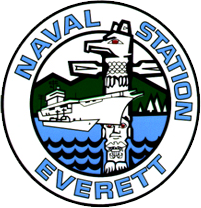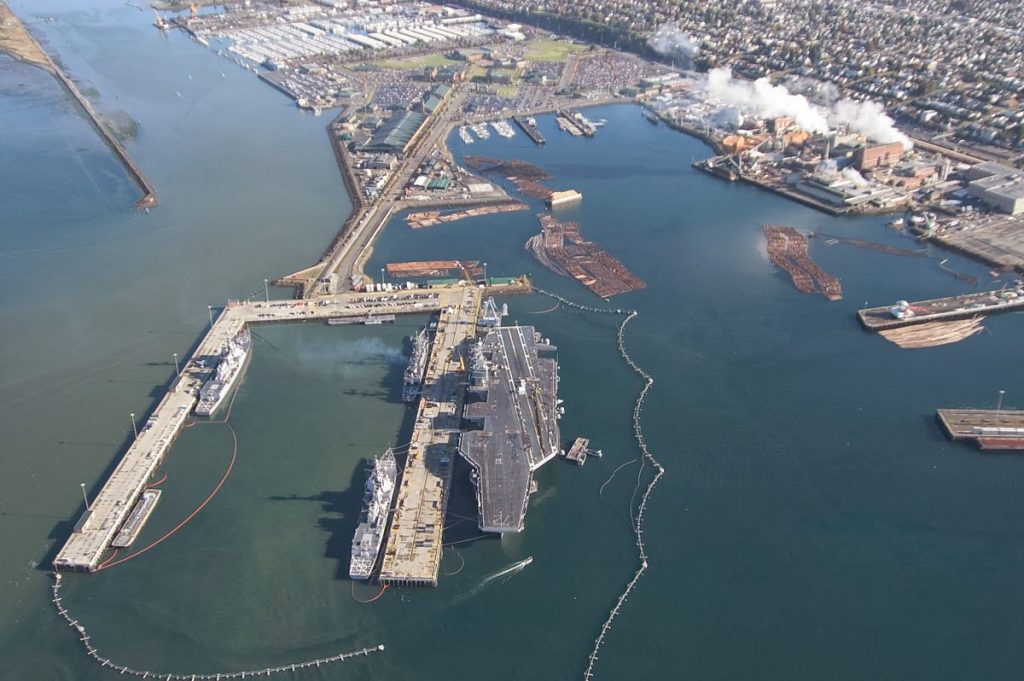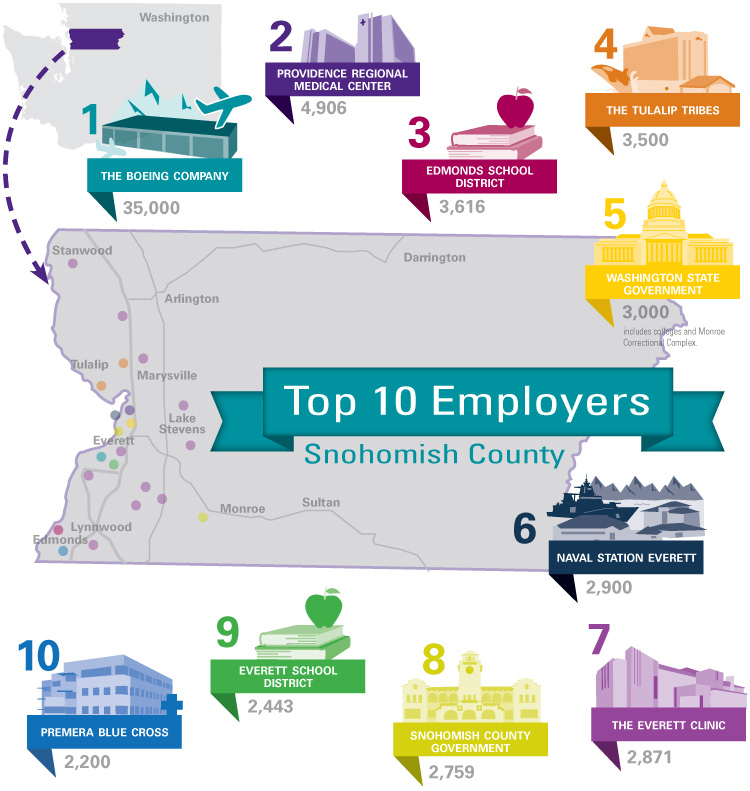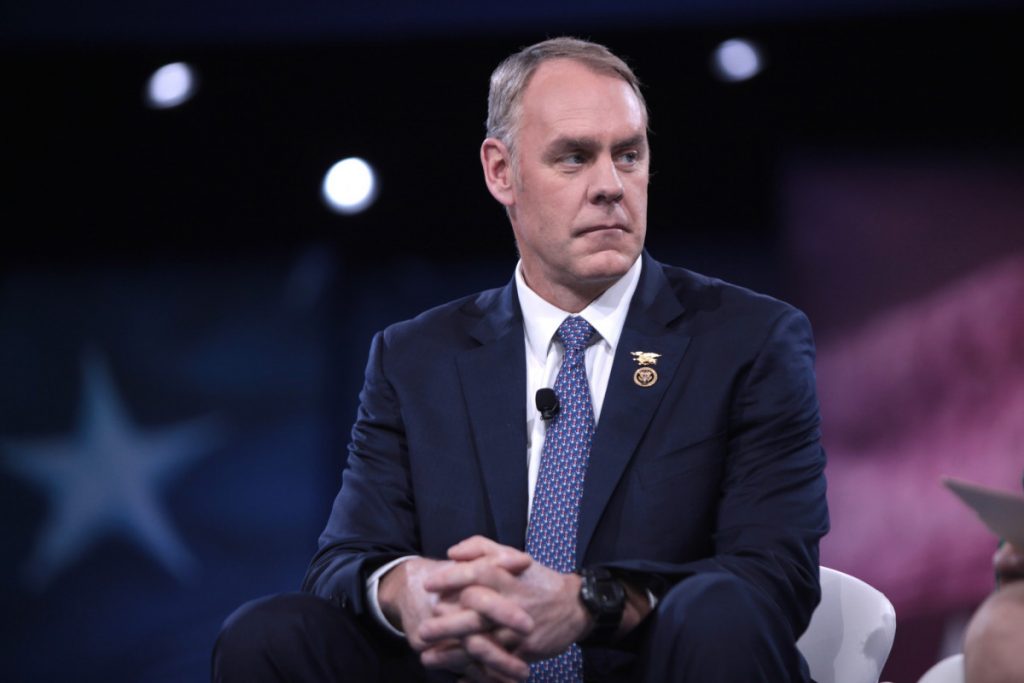
Seth Wright
Naval Station Everett (NSE) is the homeport of Carrier Strike Group 11, claimed “as the single most powerful mobile force in the world,” and at the moment, home to approximately 3,000 sailors (MARCOA 2018) NSE also “supports mission-critical functions at Jim Creek Radio Station in Arlington and Naval Facility Pacific Beach on Washington’s Pacific coast. The radio station maintains communication with submarines in the Pacific” (CNIC 2019).
Naval Station Everett resides on the coast of Everett, Washington, a city of about 100,000 people (Eernissee 2019). The base itself is quite new (being completed in 1994) and so it is hard to observe its long-term effects, in all aspects. I will first introduce its brief history as well as briefly discuss the concept of homeporting, then discuss its impact on the local area (socially, economically, and environmentally), its national impact and lastly, its global impact.
Military Bases.com describes the “[b]ase [a]menities [as follows]: NS Everett is the most modern base in the United States Navy, therefore the facilities on site have to stand up to the expectations. Those who are deployed there have no reasons to feel like foreigners. The US Navy has made all the efforts to make people feel like home. There are family centers, community clubs, an exchange, a commissary, educational offices and schools, not to mention about a chapel. The multitude of shops is organized on particular niches. For instance, there is a popular thrift shop, as well as a complete auto hobby store.
When after recreational activities, there are a lot of courts for basketball and other similar sports. There are also pubs and bars for relaxation” (militarybases.com 1998).
Base History
In 1984 the Navy proposed building a new homeport in Everett (White 1984). The sale of the land was delayed to allow for the public to vote and debate over the construction of the base’s pier. Everett voters were in favor of the base by a margin of 2-1. By 1987 the sale of the proposed land was confirmed as 143 acres of land for $43.5 million (Riddle 2011). In 1987, a 500-meter pier was built for roughly $50 million. The naval station was not fully operational until 1994. “With the bases relatively short run time it had yet to be active for most of the engagements of the 20th century” (militarybases.com 1998).
Deployment History
Naval Station Everett is the homebase for Carrier Strike Group 11. In its short lifespan, NSE has deployed forces primarily to help secure control of areas in the Pacific, as well as aiding in the search for the missing Malaysian airline flight in 2014 (Wikipedia 2019). The USS Shoup has been a part of Exercise Valiant Shield, a series of joint exercises to test a “wide range of capabilities such as amphibious operations, maritime security operations, anti-submarine and air-defense exercises. At VS-18 it was also demonstrated the joint forces flexibility” (Zdravkova 2018).
Ship Rotation History
Carrier Strike Group 11 is currently without its Carrier. The USS Nimitz was the last aircraft carrier stationed there and has yet to be replaced. (MARCOA 2018). But other ships are based at NSE. “On Sept. 3, 1994, USS Ingraham (FFG 61) and USS Ford (FFG 54) arrived as the first of seven ships to be assigned here. On Nov. 22, 1995, USS Paul F. Foster (DD 964) arrived at the naval station. On that same date, the Navy officially announced the assignment of USS David R. Ray (DD 971), USS Callaghan (DDG 994) and USS Chandler (DDG 996) to Naval Station Everett. USS David R. Ray arrived July 29, 1996, and USS Callaghan and USS Chandler both arrived Sept. 27, 1996. To complete the complement of ships at Naval Station Everett, USS Abraham Lincoln (CVN 72) made a change of homeport from Puget Sound Naval Shipyard at Bremerton to Everett Jan. 8, 1997 (MARCOA 2018).

In March 1998, USS Callaghan was decommissioned, and in May 1998, two ships based in Japan, USS Fife (DD 991) and USS Rodney M. Davis (FFG 60), made their official change of homeport to Everett… Today, the station is home to six Navy ships and two Coast Guard ships: USS Shoup, USS Momsen, USS Kidd, USS Gridley, USS Sampson, USS Ralph Johnson, USCGC Blue Shark and USCGC Henry Blake.”
Homeporting
Homeporting is the grouping of ships so they learn to better operate together as a unit, rather than be scattered at different ports. The Navy does not need to create as much infrastructure such as roads and railways for a homeport cluster of ships, and is able to economically strengthen those cities. It is easier to repair ships as a fleet with the same homeport so resources do not have to be as spread out. Some homeports are also stationed in range of unstable areas and effectively increase their overall readiness for combat.
But there are drawbacks of homeporting. An adversarial nation could easily target these areas. There is little need for the homeports that exist in the Gulf of Mexico. With overhaul cycles of ships, there will only be small segments of time when the entire homeport group trains together (Coburn 1991).
Local Impacts
Naval Station Everett is currently home to 3,000 sailors, but with the probable future return of an aircraft carrier, that number would double. “Economists say that for every three Navy jobs introduced to the area, roughly two additional jobs are generated in construction, retail, sales and service industries” (Pritchett 1995). Because of this statistic, the people of Everett want to have a aircraft carrier stationed in their port again.
Byproducts of this base include the Navy’s ability to be “far more attentive to our veterans, [and] we’re far more attentive to our patriotic holidays.” A city employee who had worked on the bases issues since its proposal said, “[T]he Navy gave us a new dimension to our culture” (Haglund 2010).
There have not been many public complaints about the base found online. The only contemporary complaint I found was about the base’s actions was about emergency speaker system testing.
Local Economic Impacts
The base has helped add more depth and stability to the job market that is predominantly under Boeing, the aircraft manufacturer. NSE is the 5th largest employer in Snohomish County, including the aforementioned 3,000 sailors. The base directly and indirectly accounts for 5% of the job market, depending on the presence of an aircraft carrier (currently only 2%). When there is an aircraft carrier present, the sum of direct and indirect jobs totals to around 10,000. Boeing with 35,000 employees, employs at least 3.5 times more people than NSE (Economic Alliance Snohomish County 2017). The City of Everett seemingly does not need NSE for economic support, but would prefer to have it for economic diversity. According to the Everett Economic Comprehensive Plan, the city plans to retain the naval base. City Policy 7.4.2 states as a goal to

“Work with the Port to increase international trade on the waterfront, to promote tourism activities at Waterfront Place and to keep the Navy on the waterfront.”
City Policy 7.4.3 sets as a goal, “Preserve the deep-water working waterfront and plan and design open space and recreation compatible with continued industrial use,
Naval Station Everett, and new commercial activities
in waterfront areas” (City of Everett 2018).
Environmental Impacts
Environmental issues started with the naval station construction. The proposed area for the base’s pier had been polluted by previous construction by the city, and this area was not suitable for construction. The polluted sediment needed to be dredged, and the amount of sediment that needed to be removed was nearly one million cubic yards. The area was historically a very productive area for Dungeness crab and other shellfish. The U.S. Environmental Protection Agency (EPA) and the Tulalip Tribes both objected to the construction. Construction started after the Navy and the Tulalip Tribes settled for $3.4 million, to dredge the proposed area (Riddle 2011).
In more recent years, the base has been claimed as one of the most environmentally friendly bases in the Navy. NSE received the Navy Pollution Prevention Award in 2006. By comparison, Bremerton’s Puget Sound Naval Shipyard (PSNS) is the 9th most polluting naval base in the U.S.. In 1994, PSNS was reported to have produced “94,900 pounds of toxic chemicals into the air, water and soil” (see Puget Sound Naval Shipyard).
To relate this back to NSE, Boeing in Everett “released 790,285 pounds of toxic chemicals into the air and water during the same period” (Pritchett 1996). Naval Station Everett “relies on its civilian and military personnel, visitors, and contractors to follow environmental procedures and requirements in order to meet objectives, address environmental issues and continually improve environmental performance” (Barton 2014). Similar to economic impacts, Boeing is much more prevalent in environmental violations in Snohomish County.
Fossil Fuels Terminal Proposals
NSE has yet to be directly named but former Interior Secretary Ryan Zinke, has looked for a reliable passage for coal shipments from Montana mines to the Pacific since 2015. Ryan Zinke, previously as a congressman, has a history of taking contributions from major coal companies. While giving the keynote address to the Louisiana Oil and Gas Association, he said behind closed doors, “Government should work for you” which was met with a standing ovation (Irfan 2018).
In March 2016, Zinke “publicly lashed out at the Army Corps of Engineers, calling for a federal investigation of Colonel John Buck, the district commander overseeing the environmental review process for the proposed Gateway Pacific coal terminal [near Ferndale, Washington]. Zinke was apparently incensed by rumors that the Corps was preparing to halt its review process in response to claims by the Lummi Nation that the project would violate the tribe’s constitutionally protected treaty rights. But on April 1, the Gateway Pacific backers themselves asked to suspend work on the project’s environmental review process, apparently fearing that the Army Corps would indeed honor the Lummi’s claims and put a stop to the project. Zinke may not recognize that the prospects are dimming for coal exports, but it seems his big financial backers” (Place 2016).
In October 2018 former secretary Zinke “expressed an interest in using military or government properties on the West Coast to handle U.S. coal or natural gas exports, thereby circumventing local opposition to fossil fuel projects. ‘I respect the state of Washington and Oregon and California,’ Secretary Zinke told the AP in an interview. ‘But also, it’s in our interest for national security and our allies to make sure that they have access to affordable energy commodities’”. (MAREX 2018). Washington Governor Jay Inslee said in response, “The men and women who serve at our military bases are there to keep our country safe, not to service an export facility for private fossil fuel companies… This reckless, harebrained proposal undermines national security instead of increasing it, and it undermines states’ rights to enforce necessary health, safety and environmental protections in their communities” (MAREX 2018).

“[Secretary Zinke] specified only one site, for natural gas: the former Adak Naval Air Facility in Alaska’s Aleutian Islands, which he suggested could receive fuel by barge from the North Slope. The base closed in 1997 and has been largely abandoned. Roughly 300 people live in the town of Adak, the westernmost community in the U.S.
“A $680 million project in Longview, Washington, was denied a key permit [in 2017] by state regulators who said it would increase greenhouse gas emissions and cause ‘significant and unavoidable harm to the environment’” (Brown 2018). If this plan had come to fruition, it would add to an already existing burden because “Washington state’s biggest polluter in 1994, in terms of toxic releases, was the giant Weyerhaeuser Co. plant in Longview, said Idell Hansen of the Department of Ecology. It released 3.3 million pounds of toxic compounds into the air and water” (Pritchett 2016).
There is a chance that NSE will be in this conversation at some point, because it is one of the very few (if only) military ports on the Northwest coastal mainland with access to rail lines. Prospects for a fossil fuel port at NSE are not imminent nor explicit, but nonetheless a possibility.
Target for Nuclear War
In February 2019, Russian President Vladimir Putin, in his annual State of the Nation address, among other topics outlined places and reasons to attack the U.S. “Mr. Putin said Washington was fueling a new arms race by withdrawing from a landmark nuclear weapons treaty [on Intermediate Nuclear Forces] and possibly deploying new missiles in Europe. Without mentioning any country in particular, he warned that if American missiles were deployed on the continent, within a few minutes’ flight of his country, Russia would aim its weapons at those missiles and at targets in the United States.”
“Russia will be forced to create and deploy new types of weapons that could be used not only against the territories where a direct threat to us comes from, but also against the territories where decision-making centers directing the use of missile systems threatening us are located,’ he said. ‘The capability of such weapons, including the time to reach those centers, will be equivalent to the threats against Russia’” (Russian Incite 2019).
A Russian news station then identifed strategic control centers as prime nuclear targets: The Pentagon, Camp David, Fort Ritchie (Maryland), Fort McClellan (California), and Jim Creek (Washington) (Russian Incite 2019).
NSE is charged to assist the nearby Jim Creek radio station in its communications with Trident submarines. Whether or not the naval station will be able to defend itself, it is now within Russian nuclear crosshairs.

Conclusion
Naval Station Everett is not a major resource for Everett, nor is it a major burden. At this point in time the City and the Navy coexist efficiently. Due to the small scale of the base, it does not overwhelm Everett, nor does it support the city in regards to the local economy. As long as NSE retains its stance on energy efficiency and does not expand its port, NSE will not be an environmental burden.
Everett could one day see coal and other fossil fuel exports come through the port, but as long as Pacific Coast states hold firm in not allowing such transportation through military ports, there will not be an issue. Everett happens to be in a very strategic and valuable place for the military, which is an advantage and disadvantage to the city, much as it would be to an opposing nation.
Sources
Barton, T. (2014, October 31). Naval Station Everett: Environmental Management System (EMS).
Brown, M. (2018. October 15). West Coast Military Installations Eyed for US Fuel Exports. Seattle Times.
City of Everett. (2018). Chapter 7: Economic Development. Everett Comprehensive Plan.
Coburn, R. (1991) Strategic Homeporting a Tactical Perspective. Fort Belvoir, VA: Defense Technical Information Center.
Eernissee, D. (2019). Everett. Economic Alliance Snohomish County (blog).
Haglund, N. (2010, December 19). Navy Carrier Base Has Been Good for Everett. Peninsula Daily News.
Irfan, U. (2018) Ryan Zinke to the Oil and Gas Industry: ‘Our Government Should Work for You. Vox.
Johnson, B. (2018, June 29). Naval Base Everett Outdoor Speaker System Testing Through August 2nd. Everett Post. everettpost.com
MacFarquhar, N. (2019, February 20) Threatening U.S., Putin Promises Russians Both Missiles and Butter. New York Times.
MARCOA Media. (2018, November 11). NS Everett: Our Military. My Base Guide.
MAREX. (2018, October 15). Trump Administration Considers Naval Bases for Coal, LNG Terminals. The Maritime Executive.
MilitaryBases. (2019). NS Everett Navy Base in Everett, WA. MilitaryBases.Com.
Navylifepnw. (2018). Everett Navy Life PNW.
Place, E. (2016, April 6). Rep. Ryan Zinke, Coal Export’s Man in Congress. Sightline Institute (blog).
Pritchett, L. (1995, March 28). Impact of Navy. Kitsap Sun. kitsapsun.com
Pritchett, L. (1996, May 3). PSNS No. 9 in Navy polluters. Kitsap Sun.
Riddle, M. (2011, July 29). Port of Everett Commissioners Approve the Sale of Land to the U.S. Navy for an Aircraft Carrier Base on May 5, 1987. HistoryLink.
Russia Insight. (2019) BREAKING! Russian TV Reveals American Locations Kremlin Would Target With Hypersonic Zircon. YouTube.
Smith, M. (2017). Industry and Major Employers Economic Alliance Snohomish County (blog). Economic Alliance Snohomish County.
Sommers, Dr. P. (2004). FY06 Pollution Prevention Award: Naval Station Everett, Washington. Denix.osd
U.S. Navy. (2019). Naval Station Everett History. CNIC.
White, J. (1984). Navy Chooses Puget Sound City For New Battle Group.
Wikipedia. (2019). Carrier Strike Group 11. Wikipedia.
Zdravkova, G. (2018, September 26). The US Exercise Valiant Shield 2018 Is Successfully Completed. Bulgarian Military Industry Review.
